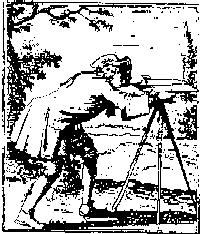|
Throughout the smooth-bore era great emphasis was placed on the ability of Gunners to judge distances, and they were frequently exercised in this skill at ranges up to 2000 yards (1829 metres). In field artillery the No 1 estimated the range to his target by experience. This was not as difficult as might be supposed, as field guns rarely opened fire at ranges over 1000 yards (914 m), their maximum effective range. Not only did the striking power of roundshot fall off rapidly over this range, but the layer had difficulty in distinguishing the target. Telescopes were not fitted to guns prior to the last two decades of the 19th century, and then only to coast artillery equipments.
No serious attempts to obtain ranges by instrumental methods were made before 1770. That year saw the short base method put to limited use, eg for siege purposes, but it was a time-consuming process. Development of efficient optical rangefinders did not commence until 1860, at the start of the rifled era, and culminated in the introduction of the well-known Barr & Stroud types 20 years later.
T=target, G=gun, GB=sub-base. |

|
|
WL Ruffell Issue 90 June 1996 |
previous | index | next |
History Home Page | Old Comrades' Home Page
Send suggestions or comments to the Webmaster
Page last updated: December 7, 1998